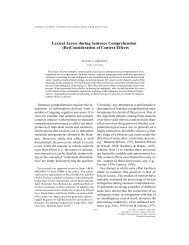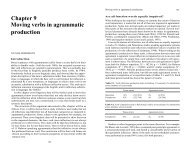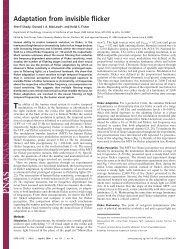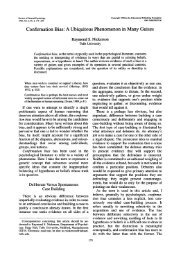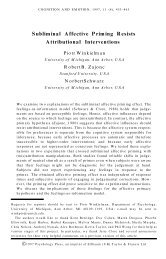4 Lexical Processing and Sentence Comprehension in Aphasia
4 Lexical Processing and Sentence Comprehension in Aphasia
4 Lexical Processing and Sentence Comprehension in Aphasia
You also want an ePaper? Increase the reach of your titles
YUMPU automatically turns print PDFs into web optimized ePapers that Google loves.
4. LEXICAL PROCESSING AND SENTENCE COMPREHENSION 127were each comprised one closed-class item (e.g., BUT), one high frequencyopen class item (e.g., PUT), <strong>and</strong> one low frequency open-class item(e.g. BAT). In each such triplet, the closed-class item was approximately10 times more frequent that the high frequency open-class item, which, <strong>in</strong>turn, was approximaely 10 times more frequent than the low frequencyopen-class item. In addition to the three prose passages, we prepared ascrambled word version of one of the passages, <strong>in</strong> which the words with<strong>in</strong>each sentence were r<strong>and</strong>omly ordered.We tested neurologically <strong>in</strong>tact patients, agrammatic aphasic patients,<strong>and</strong> Wernicke's aphasic patients with this material. To m<strong>in</strong>imize taskspecificstrategies, the patients were <strong>in</strong>structed to read each passage at normalspeed <strong>and</strong> they were timed with a stopwatch to encourage them not toread more slowly than they do normally. Further, they were asked multiplechoice questions <strong>in</strong> the middle <strong>and</strong> at the end of each of the passages to ensurethat they were read<strong>in</strong>g for mean<strong>in</strong>g <strong>and</strong> not just scann<strong>in</strong>g the letters.F<strong>in</strong>ally, <strong>and</strong> as forecast, <strong>in</strong> order to determ<strong>in</strong>e how resistant the openclosedclass difference is to attentional dem<strong>and</strong>s, we <strong>in</strong>structed a subset ofthe neurologically <strong>in</strong>tact subjects to pay special attention to small wordslike by or such, as these are often neglected on the task.The data we obta<strong>in</strong>ed are rather straightforward. First, the neurologically<strong>in</strong>tact subjects: We confirmed previous reports that they are less able to detecttarget letters <strong>in</strong> closed-class items than <strong>in</strong> open-class items. In addition,we observed no effect of frequency per se on the error pattern. That is,when we considered performance for targets embedded <strong>in</strong> the tripletsstepped <strong>in</strong> frequency, we found a significantly higher proportion of detectionerrors <strong>in</strong> the closed-class items than <strong>in</strong> the high <strong>and</strong> low frequencyopen-class items, but no significant difference between the high <strong>and</strong> lowfrequency items with<strong>in</strong> the open class. We also found the normal openclosedclass target detection difference to be significant <strong>in</strong> the prose conditionbut not <strong>in</strong> the scrambled condition, <strong>in</strong>dicat<strong>in</strong>g that the <strong>in</strong>visibility ofclosed-class items is <strong>in</strong> some way dependent on sentence pars<strong>in</strong>g <strong>and</strong> <strong>in</strong>terpretation.And we noted no significant performance differences betweensubjects who were specifically <strong>in</strong>structed to attend to the closed class <strong>and</strong>those who were not forewarned, suggest<strong>in</strong>g that the greater number ofclosed-class errors observed on this task reflects the operation of a normallyautomatic <strong>and</strong> impenetrable process<strong>in</strong>g mechanism. Of course, aclear c<strong>and</strong>idate for such a mechanism is the closed-class word retrieval systemthat we have described-the system that is, by hypothesis, <strong>in</strong> the serviceof a parser.With respect to the aphasic patients, we found that for st<strong>and</strong>ard prose,the Wernicke's patients, like the neurologically <strong>in</strong>tact patients, were less ableto detect target letters <strong>in</strong> closed-class items than <strong>in</strong> open-class items,whereas the agrammatic aphasic patients detected targets with an almostequal facility <strong>in</strong> the two vocabulary classes. These data are also compatible



